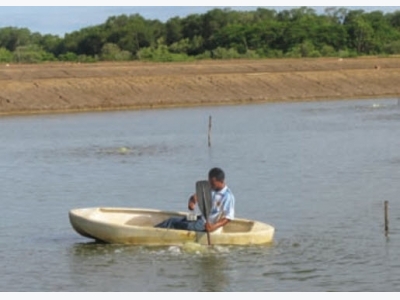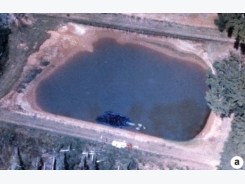Dissolved Oxygen Management In Aquaculture

Regular monitoring can identify changing D.O. levels and avoid stressful impacts on culture animals.
Summary:
Dissolved-oxygen concentrations in aquaculture ponds are typically above saturation during the day, then drop during the night. Management of D.O. in ponds with static water is difficult, so managers of nonaerated ponds usually limit stocking and feeding rates. When used, aerators usually are most effective during nighttime. In cage and net pen culture, D.O. concentrations usually cannot be influenced by management
Although molecular oxygen comprises about 21% of atmospheric gases, its concentration in waters of aquaculture facilities can be unacceptably low for good survival and growth of culture species. Like other atmospheric gases, oxygen has a characteristic solubility, and its dissolution in water is directly proportional to its percentage composition and partial pressure in the atmosphere.
The pressure of oxygen in air above a water surface forces oxygen molecules into the water until the pressure of oxygen in the water equals that in the air. This state is known as oxygen saturation. Molecular oxygen contained in water is called dissolved oxygen (D.O.)
Concentration in Water
The D.O. concentration, usually expressed as a weight/ volume relationship such as milligrams per liter, at saturation decreases with increasing water temperature and salinity (Table 1), and also as barometric pressure falls. The following equation may be used to convert D.O. concentrations for standard pressure to those at saturation for other barometric pressures.

For example, suppose the water temperature in a freshwater pond is 20° C and the barometric pressure is 710 mm. The D.O. concentration at saturation is 8.48 mg/l – about 0.6 mg/l less than at 760 mm pressure.
Daily changes in barometric pressure are relatively small and have effects of only 0.1 or 0.2 mg/l on D.O. concentration. Barometric pressure differs greatly with changes in elevation. The solubility of D.O. at 20o C in freshwater is 9.08 mg/l at sea level, but only 7.19 mg/l at 2,000 m, where the pressure averages 608 mm.
The D.O. concentration at saturation increases with increasing water depth because hydrostatic pressure adds to the barometric pressure acting on the water surface.
Table 1. Solubility of oxygen (mg/l) as a function of temperature and salinity in moist air at 760 mm barometric pressure. From Benson and Krause, 1984.
| Temperature (° C) | Salinity (ppt) | ||||||||
| 0 | 5 | 10 | 15 | 20 | 25 | 30 | 35 | 40 | |
| 0 | 14.602 | 14.112 | 13.638 | 13.180 | 12.737 | 12.309 | 11.896 | 11.497 | 11.111 |
| 5 | 12.757 | 12.344 | 11.944 | 11.557 | 11.183 | 10.820 | 10.470 | 10.131 | 9.802 |
| 10 | 11.277 | 10.925 | 10.583 | 10.252 | 9.932 | 9.621 | 9.321 | 9.029 | 8.747 |
| 15 | 10.072 | 9.768 | 9.473 | 9.188 | 8.911 | 8.642 | 8.381 | 8.129 | 7.883 |
| 20 | 9.077 | 8.812 | 8.556 | 8.307 | 8.065 | 7.831 | 7.603 | 7.382 | 7.167 |
| 25 | 8.244 | 8.013 | 7.788 | 7.569 | 7.357 | 7.150 | 6.950 | 6.754 | 6.565 |
| 30 | 7.539 | 7.335 | 7.136 | 6.943 | 6.755 | 6.572 | 6.394 | 6.221 | 6.052 |
| 35 | 6.935 | 6.753 | 6.577 | 6.405 | 6.237 | 6.074 | 5.915 | 5.761 | 5.610 |
Concentration Variations
Waters do not attain D.O. saturation and remain in this state. The main reason for variations in D.O. in natural waters is photosynthesis by aquatic plants and respiration by all aquatic organisms. These processes cause D.O. concentration to change faster than the diffusion of oxygen between air and water can maintain a saturated state. Typically, water in aquaculture ponds has D.O. concentrations above saturation during much of the day that then drop below saturation during nighttime.
Molecular oxygen diffuses from water to air when D.O. levels exceed saturation and from air to water when the concentrations are less than saturation. The difference in D.O. concentration and saturation is the D.O. deficit. The greater the deficit, the larger is the tendency for oxygen to exchange across the water surface. Moreover, turbulence of the water surface from wind or splashing over rocks results in more rapid oxygen exchange.
The amount of D.O. in water sometimes is expressed as percentage saturation according to the following equation.

Effects on Aquaculture Species
In ponds, surface water often is less than 50% saturated with D.O. in the early morning and above 200% saturation by mid-afternoon. D.O. supersaturation seldom is harmful to fish or shrimp. Supersaturation of water with air, however, can be a major problem in trout or other hatcheries by causing gas bubble trauma.
The effects of D.O. concentration on aquaculture species usually are reported on a concentration basis for the optimum temperature range of the species under consideration (Table 2). In reality, aquatic animals respond to the pressure of oxygen in the water instead of D.O. concentration.
D.O. Management
Management of D.O. in ponds with static water is difficult, for plankton, benthos, and other organisms use more D.O. than is used by the culture species. Managers of nonaerated ponds usually limit stocking and feeding rates to those that have proven safe in the past. In channel catfish farming, for example, feed inputs to nonaerated ponds are limited to 30-40 kg/ha/day.
Prudent managers measure D.O. concentration at night and apply emergency aeration with tractor-powered, emergency aerators when necessary. Aeration of channel catfish ponds with electric aerators allows daily feed inputs above 100 kg/ha and up to fourfold more production than that possible in nonaerated ponds.
When aerators are operated during the daytime, they increase the loss of oxygen to the air if pond water is supersaturated with D.O. Aerators usually are most effective in transferring oxygen to water during nighttime. In ponds, the culture species must compete with other organisms for the added D.O. Studies of channel catfish ponds suggested that only 15-25% of the D.O. provided by aerators is used by the culture species.
Table 2. Effects of dissolved-oxygen concentration on warmwater pond fish.
| Dissolved Oxygen (mg/l) | Approximate Percentage Saturation at 20° C | Effect |
| 0-0.3 | 0-4 | Small fish survive short exposure |
| 0.3-1.0 | 4-13 | Lethal if exposure prolonged |
| 1.0-5.0 | 13-64 | Fish survive, but growth slow for prolonged exposure |
| 5.0-Saturation | 64-100 | Desirable range |
Flow-Through, Cage Systems
In flow-through aquaculture systems, rapid water flow prevents the growth of plankton and flushes out wastes. Nearly all the D.O. in inflowing water is available to fish. Stocking and feeding rates in trout raceways are established so that D.O. concentration does not fall below 5 mg/l and stress the fish.
Suppose that water containing 10 mg/l D.O. enters a raceway at 10 m3/ minute. The water supply has 5 mg/l of available D.O. or 72 kg D.O./day (5 g/ m3 × 10 m3/minute × 1,440 minutes/day × 10-3). It usually is possible to apply 5 kg feed for each kilogram of D.O., so 360 kg feed can be applied daily. The fish biomass necessary to fully use the available D.O. at a feeding rate of 3% body weight daily would be 12,000 kg (360 kg feed/day ÷ 0.03).
The steps in the calculation above can be incorporated into the following equation for calculating the carrying capacity of flow-through systems.

Aeration also can be used to increase carrying capacity in flow-through systems. However, in raceways, almost the entire amount of D.O. supplied by aeration would be available to the fish, for there are few other organisms present to use it.
In cage and net pen culture, or culture of bivalve shellfish, the D.O. concentrations in the water result from natural conditions and usually cannot be influenced by management. Sites for such aquaculture projects should provide high-quality water and good circulation. Many cage culture operations have experienced serious losses to D.O. depletion when thermal destratification of eutrophic lakes occurred.
Có thể bạn quan tâm
Phần mềm

Phối trộn thức ăn chăn nuôi

Pha dung dịch thủy canh

Định mức cho tôm ăn

Phối trộn phân bón NPK

Xác định tỷ lệ tôm sống

Chuyển đổi đơn vị phân bón

Xác định công suất sục khí

Chuyển đổi đơn vị tôm

Tính diện tích nhà kính

Tính thể tích ao hồ



 Measuring Dissolved Oxygen Concentration in Aquaculture
Measuring Dissolved Oxygen Concentration in Aquaculture  Feeding Affects Pond Water Quality
Feeding Affects Pond Water Quality